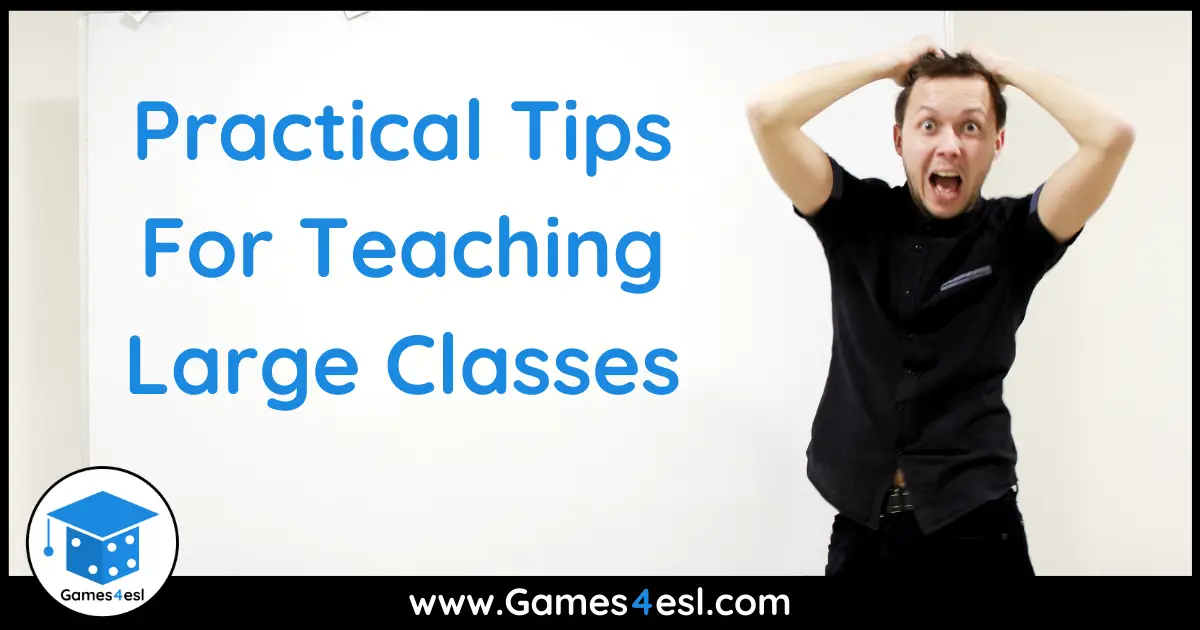Practical Tips For Teaching Large Classes
Teaching kids is not easy, and with large class sizes, teachers may feel overwhelmed and feel like their oversized class is unmanageable. Kids are often easily distracted and find it difficult to follow simple instructions. To help you manage your classroom with many students, follow these 5 practical tips for teaching large classes.
You May Also Like: 15 Fun Classroom Attention Getters
5 Practical Tips For Teaching Large Classes
1. Have A Classroom Routine
A classroom routine is essential when teaching large classes. A classroom routine will help young learners to understand what to do and when to do it. Establishing a classroom routine can take some time, but stick with it and your class will run much more smoothly. Some things you can include in your classroom routine are:
Begin every class in the same way.
This lets students know that break time is over and it is time to start the class. For example, when it is time to start the class, the teacher can begin a countdown from 5. When the countdown reaches 1, all students should be sat in their seats and ready.
End every class in the same way.
If students begin packing their bags, moving around, etc, before the class is finished, this can be very distracting, especially in large classes of students. To prevent this, you can end every lesson in the same way.
For example, the teacher could, at the end of the lesson, ask the students to pack their bags and stand up behind their chairs. Once all the kids have packed up and are standing behind their chairs, the teacher can let the group of students who are standing quietly go first. Not only does this help to keep order at the end of the class, but it also prevents 30+ kids from running for the exit as soon as the bell rings, which can be very dangerous.
Use the same simple classroom language in every class.
Using the same simple phrases in every class can be a powerful way to manage large classes. Drill these expressions every lesson for the first week or so and students will soon be following the teacher’s instructions easily. For example, the teacher can say “Be…”, and the students should reply “quiet”, / T: “Look at the…” S: “teacher” / T: “Listen…” S: “carefully”, etc. Here are 15 more call and response examples you can use.
Practice/Drill.
Making groups, lining up, moving around the class, etc, can be chaotic with 30+ students in a small classroom. Establish a routine and practice/drill these routines. For example, to make groups the teacher can say “Group work!” to signal that the students should make a group. Then the students move their desks/chairs as they have practiced.
2. Use Quiet Music

With large class sizes, when doing activities in pairs or working in groups, the class can get very noisy. You will find that as it gets louder, the kids will begin to talk louder, and this can quickly become chaotic and distracting, and not very conducive to learning. One very simple and effective method of keeping the class volume down is to use quiet music. While students are completing the tasks, the teacher can play some music.
Volume is important!
If the music is too loud, then students will just speak louder. If the music is too quiet, the students won’t notice it and will just continue being noisy. But if the music is quiet but loud enough for them to hear it, then you’ll find that students will naturally speak quieter to hear the music as they are completing their tasks.
TIP: If using YouTube to play the music, minimize the window so you can only hear the music. If the kids can see the video, they will just watch the song and not focus on the task at hand.
3. Minimize Distractions
Students can be distracted easily, and this is especially true with kids. Young learners will touch, pick up, play with anything that is in front of them. Rather than focusing on the teacher, the students will be focusing on what’s in front of them, and at the same time, they will be distracting the students around them. To minimize potential distractions, follow these tips:
If students don’t need it for the lesson, don’t allow it on their desks.
Obviously, students should not be allowed to bring in toys and games and play with them on their desks during the lesson. But teachers should also consider keeping other things off their desks, such as books, pencil cases, colored pencils, etc, until it is needed in the lesson.
You’ll find with these things on the desk, rather than focus on what the teacher is saying, kids will often do things like rearrange things in their pencil case, draw things on their books, look through the textbook, rearrange their color pencils, etc.
I once had a grade one student bring in a see-through ‘briefcase’ full of colored pencils and crayons to the class that took up all the space on her desk. While I was explaining an activity, she tried to pick up the briefcase only for it to come open and spill her 100+ color pencils all over the classroom floor. And there was no activity requiring color pencils in that lesson! If they don’t need it for the lesson, keep it off their desks.
Don’t give out worksheets, board games, materials, etc, until you have explained and demonstrated the activity.
Getting a large class of students to understand how to complete a task can be particularly challenging. Students may find it difficult to follow simple instructions. Therefore, it is important for young learners to SEE and HEAR you as you model/demonstrate how to complete a task.
If you provide young learners with the worksheets/game materials first, you will find that they will be looking at, and playing with the materials, rather than listening and focusing on the teacher. Instead, demonstrate the activity first, and then model the activity with a student. Then you can check their understanding before handing out the necessary materials.
Encourage young learners to use the bathroom before the class starts.
Having students asking to go to the bathroom every few minutes, and having students coming and going from the classroom throughout the class and be very distracting. Furthermore, these kids and the distracted students will likely miss some important information about how to do the task. Ask students to go to the bathroom before class, but at the end of the day, if you’ve gotta go, you’ve gotta go.
4. Timing Is Important

Many learners have a short attention span and keeping a large class focused can be very difficult. Timing can play a crucial role in keeping or losing your students’ attention. A well-planned lesson will ensure that one activity smoothly follows on from the last without much time in between for students to become distracted.
This is also true when explaining and demonstrating games and activities. Plan in advance how you will explain and model how to complete a task. This way you can ensure that your explanation/demonstration is short, concise, without significant gaps so that the students don’t have a chance to get distracted.
5. Keep Students In Their Seats

You’ll find that with many students, especially very young learners, when they have a question or when they have completed a task, they will stand up and walk to the teacher to ask/show them. With a large class of students, it can quickly feel that you are losing control of the class as many students move around and crowd around the teacher as they compete for his/her attention.
To prevent this, have a class rule that students must stay in their seats. Ask them to raise their hand if they have a question, or when they finish and go to them while they stay in their seats.
Thanks for reading. I hope you found these tips for managing large classes useful. Before you go, be sure to check out our free resources for teaching English, including ESL games, ESL worksheets, PowerPoint Games, PowerPoint Lessons, and more.

